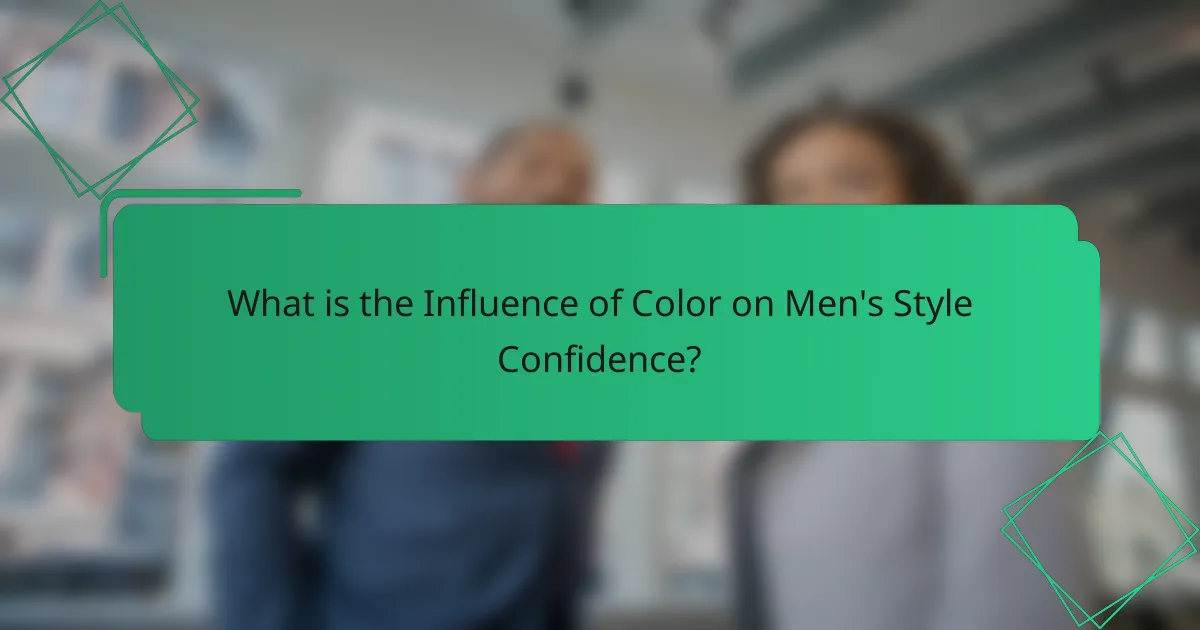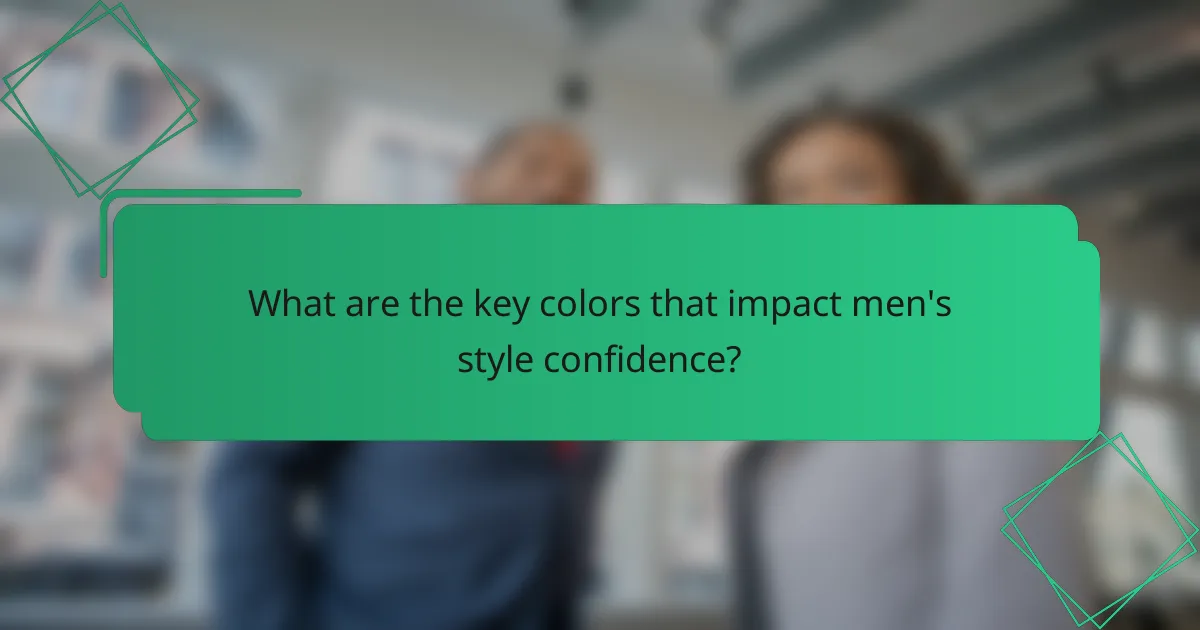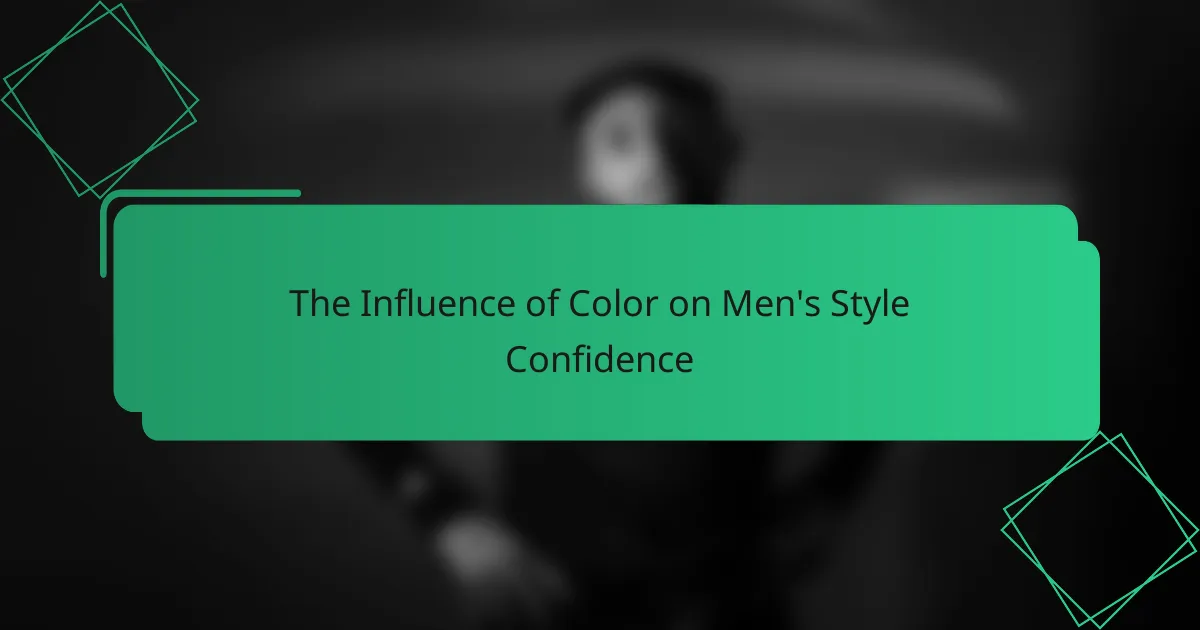Color significantly impacts men’s style confidence by influencing emotions and perceptions associated with different hues. Key colors such as black, navy blue, and gray are linked to authority, trust, and sophistication, enhancing perceived confidence levels. Research indicates that men feel more self-assured when wearing colors that resonate with their personality and complement their skin tone. Additionally, bold colors like red can convey assertiveness, while the context of color choice affects the overall impression, with lighter shades suggesting a relaxed vibe and darker tones representing professionalism. Understanding color psychology allows men to strategically select colors that boost their confidence and enhance their appearance.

What is the Influence of Color on Men’s Style Confidence?
Color significantly influences men’s style confidence. Different colors evoke various emotions and perceptions. For instance, wearing blue is often associated with trust and professionalism. Studies show that individuals feel more confident in colors that resonate with their personality. A 2018 study published in the Journal of Experimental Psychology found that wearing red can enhance confidence levels during performance tasks. Additionally, colors like black and gray are linked to authority and sophistication. Men who choose colors that align with their desired image often report feeling more self-assured. Thus, color plays a crucial role in shaping men’s confidence in their style choices.
How does color psychology relate to men’s fashion choices?
Color psychology significantly influences men’s fashion choices. Colors evoke emotions and perceptions that can affect decision-making. For instance, blue is often associated with trust and reliability. Many men choose blue clothing for professional settings to convey confidence. Red, on the other hand, is linked to power and passion. Men may wear red to stand out or make a bold statement.
Studies indicate that colors can impact first impressions. Research by the University of California found that people perceive individuals wearing certain colors differently. Black is often seen as sophisticated, while lighter colors can evoke a sense of approachability. These perceptions guide men’s clothing selections in various social contexts.
Ultimately, understanding color psychology helps men make informed fashion choices that align with their desired image and emotional state.
What are the psychological effects of different colors on perception?
Different colors have distinct psychological effects on perception. For instance, red often evokes feelings of passion and urgency. Blue typically promotes calmness and trustworthiness. Yellow is associated with happiness and energy. Green often symbolizes nature and tranquility. Purple can convey luxury and creativity. Each color influences emotional responses and decision-making processes. Research by Küller et al. (2009) indicates that color can significantly affect mood and behavior. This demonstrates the importance of color choice in contexts like fashion and branding. Understanding these effects can enhance style confidence in men by aligning colors with desired emotional responses.
How do colors influence mood and self-esteem in men?
Colors significantly influence mood and self-esteem in men. Different colors evoke various emotional responses. For example, blue is often associated with calmness and stability. Wearing blue can enhance feelings of confidence and reduce anxiety. Red, on the other hand, is linked to energy and passion. It can boost self-esteem and assertiveness when worn. Studies show that colors like green promote relaxation, aiding in emotional balance. Yellow can stimulate optimism and happiness, potentially uplifting mood. The impact of color is not just psychological; it can also affect social interactions. Men who wear colors that align with positive emotions may experience increased confidence in social settings.
Why is color selection important in men’s style?
Color selection is important in men’s style because it influences perception and confidence. The right colors can enhance a man’s appearance and convey personality traits. For instance, studies show that wearing darker colors often conveys authority and professionalism. In contrast, brighter colors can express creativity and approachability. Color can also affect mood; wearing certain hues can boost self-esteem. Furthermore, color coordination in outfits can create a harmonious look, making the wearer more visually appealing. Research by the University of California found that people often make judgments about others within seconds based on color choices. Thus, strategic color selection plays a crucial role in shaping men’s style and confidence.
What role does color play in first impressions?
Color significantly influences first impressions. Various studies indicate that color affects perceptions of personality traits. For instance, warm colors like red and yellow can evoke feelings of warmth and friendliness. In contrast, cooler colors such as blue and green often convey calmness and professionalism. Research by the University of Toronto found that people associate specific colors with emotions and traits. This association can impact judgments about competence and trustworthiness. Therefore, the choice of color in clothing can shape how individuals are perceived in social and professional settings.
How can color enhance personal branding for men?
Color can significantly enhance personal branding for men by influencing perceptions and emotions. Specific colors evoke distinct associations. For example, blue conveys trust and reliability. This can be beneficial in professional settings. Red signifies power and confidence, making it suitable for leadership roles. Green is often associated with growth and harmony, appealing to those in creative industries.
Color choices can impact first impressions. Studies show that people form judgments about others within seconds based on color. A well-chosen color palette can reflect personal values and aspirations. Consistency in color use across platforms strengthens brand recognition.
Men who strategically use color in their wardrobe can stand out in a competitive environment. This enhances their visibility and memorability. Ultimately, color plays a crucial role in shaping a man’s personal brand identity.

What are the key colors that impact men’s style confidence?
Black, navy blue, and gray are key colors that significantly impact men’s style confidence. Black is often associated with authority and sophistication. It is a versatile color that can be dressed up or down. Navy blue conveys trust and reliability, making it a popular choice for professional attire. Gray serves as a neutral base, allowing for easy pairing with other colors. Studies show that wearing these colors can enhance perceived confidence levels. For instance, a survey by the fashion brand Bonobos indicated that men feel more confident in darker shades.
Which colors are considered powerful in men’s fashion?
Black, navy blue, and charcoal gray are considered powerful colors in men’s fashion. These colors convey authority and sophistication. Black is often associated with elegance and formality. Navy blue signifies trust and confidence. Charcoal gray represents professionalism and seriousness. Studies show that men wearing these colors are often perceived as more competent. For instance, a survey by the University of California found that people associate darker colors with leadership qualities. This demonstrates the significant impact of color choice on perception in men’s fashion.
What does wearing black signify in men’s style?
Wearing black in men’s style signifies sophistication and authority. Black is often associated with elegance and formality. It is a versatile color that can be adapted to various occasions. Many fashion experts note that black enhances the wearer’s presence. Studies show that individuals wearing black are perceived as more confident. This color choice can also convey a sense of mystery and intrigue. Historically, black has been favored in professional settings, reinforcing its association with power. Overall, black’s significance in men’s style is rooted in its ability to project strength and confidence.
How does blue affect perceptions of trust and authority?
The color blue positively affects perceptions of trust and authority. Studies show that blue is often associated with calmness and reliability. In a survey by the Institute for Color Research, blue was identified as the most preferred color for conveying trustworthiness. Additionally, brands that utilize blue in their logos, like Facebook and IBM, are often perceived as more credible. This association is rooted in psychological responses, where blue creates a sense of security. Research by the University of Wisconsin found that people felt more confident in leaders wearing blue. Overall, blue enhances perceptions of professionalism and dependability.
What colors should men avoid to maintain confidence?
Men should avoid colors like yellow, brown, and orange to maintain confidence. Yellow can be perceived as overly bright and may signal caution or anxiety. Brown often conveys dullness or a lack of energy, which can undermine a confident appearance. Orange, while vibrant, can come off as too loud or aggressive, which may detract from a composed demeanor. Studies have shown that colors like blue and black are more associated with power and professionalism, reinforcing the idea that certain colors can impact perceived confidence levels.
What negative associations do certain colors have?
Certain colors have negative associations that can impact perceptions and emotions. For example, black is often linked to mourning and death in many cultures. Yellow may evoke feelings of caution or anxiety, as it is associated with warning signs. Red can signify danger or aggression, often provoking strong emotional reactions. Green, while generally positive, can also represent jealousy or inexperience in some contexts. Blue may be perceived as cold or distant, leading to feelings of sadness. These associations can influence how colors are used in fashion and branding, affecting confidence and style choices.
How can clashing colors impact confidence levels?
Clashing colors can negatively impact confidence levels. When individuals wear colors that do not harmonize, it can create visual discomfort. This discomfort can lead to feelings of self-consciousness. Studies show that color coordination affects perceptions of attractiveness and social acceptance. A 2017 study by the University of California found that individuals dressed in clashing colors were perceived as less confident. Furthermore, color psychology suggests that harmonious color schemes promote positive emotions. In contrast, clashing colors may evoke confusion or unease. Thus, wearing clashing colors can diminish a person’s confidence in social situations.

How can men effectively use color to boost their style confidence?
Men can effectively use color to boost their style confidence by understanding color psychology and choosing colors that enhance their appearance. Wearing colors that complement skin tone can create a more polished look. For instance, warm skin tones often look great in earthy colors like browns and greens. In contrast, cool skin tones can shine in blues and purples.
Incorporating bold colors can also make a statement and convey confidence. Studies show that people perceive individuals wearing red as more confident and assertive. Additionally, using color strategically in outfits can create visual interest and draw attention to specific areas. For example, a bright shirt can highlight the upper body.
Men should also consider the context when selecting colors. Wearing lighter colors can evoke a relaxed vibe, while darker shades often convey professionalism. Ultimately, experimenting with different colors can lead to discovering personal preferences and styles, enhancing overall confidence in appearance.
What strategies can men employ to incorporate color into their wardrobe?
Men can incorporate color into their wardrobe by starting with accessories. Accessories like ties, pocket squares, and belts can introduce color without overwhelming an outfit. Next, men can choose colorful shirts or blouses that pair well with neutral trousers. This strategy balances bold colors with classic styles.
Layering is another effective method. A colorful jacket or sweater can add depth to an outfit. Additionally, men can experiment with patterns that include multiple colors, such as plaid or floral designs. This adds visual interest while still being stylish.
Choosing a color palette is essential. Men should select a few colors that complement their skin tone and build a wardrobe around them. This creates cohesion in their outfits. Lastly, men can gradually introduce color by mixing and matching pieces over time. This approach helps build confidence in wearing brighter hues.
How can men choose colors that complement their skin tone?
Men can choose colors that complement their skin tone by identifying their undertone. Skin tones generally fall into three categories: warm, cool, and neutral. Warm undertones suit earthy colors like oranges and browns. Cool undertones are enhanced by jewel tones like blues and purples. Neutral undertones can wear a wide range of colors, including both warm and cool shades.
To determine undertone, men can check the color of their veins. Blue veins indicate cool tones, while green veins suggest warm tones. Another method is to observe how skin reacts to different colors. Wearing gold jewelry typically flatters warm undertones, while silver suits cool tones.
Research from the Fashion Institute of Technology shows that color choices significantly impact perceived attractiveness and confidence. Men who wear colors that align with their skin tone report higher confidence levels in social settings.
What are some tips for mixing and matching colors effectively?
To mix and match colors effectively, start with a color wheel. Use complementary colors, which are opposite each other on the wheel, for a bold look. Analogous colors, located next to each other, create harmony. Neutrals can balance vibrant colors and serve as a base. Limit your palette to three main colors to avoid overwhelming combinations. Consider the 60-30-10 rule: use 60% of a dominant color, 30% of a secondary, and 10% for an accent. Patterns can be mixed, but ensure they share a common color for cohesion. Finally, test combinations in natural light to see true color interactions.
What common mistakes should men avoid when using color in fashion?
Men should avoid several common mistakes when using color in fashion. One mistake is wearing too many bold colors at once. This can create a chaotic look. Another mistake is failing to consider skin tone when choosing colors. Certain colors may wash out a man’s complexion. Over-matching is also a common error. Men should avoid matching their outfit too closely to their accessories. Additionally, neglecting to incorporate neutral colors can lead to an unbalanced wardrobe. Finally, ignoring the context of the occasion can result in inappropriate color choices. Each of these mistakes can impact a man’s overall style confidence.
How can overusing bright colors detract from confidence?
Overusing bright colors can detract from confidence by overwhelming the observer. Bright colors can create a sense of chaos, leading to discomfort. This discomfort can manifest as self-doubt in social situations. Studies show that individuals often perceive bright colors as attention-seeking. This perception can lead to judgments about one’s personality. In turn, these judgments can negatively impact self-esteem. Research indicates that color choices influence first impressions significantly. A study published in the Journal of Experimental Psychology found that colors affect mood and behavior. Therefore, excessive use of bright colors can undermine confidence by fostering negative perceptions.
What are the pitfalls of color coordination in men’s outfits?
Poor color coordination can negatively impact men’s outfits. It may lead to clashing colors that create visual chaos. Inappropriate color combinations can make an outfit appear unprofessional. Overly bright or mismatched colors can draw unwanted attention. Lack of understanding color theory can result in ineffective styling choices. Inconsistent color palettes can disrupt the overall aesthetic. Additionally, ignoring skin tone compatibility can diminish the wearer’s appearance. These pitfalls can undermine confidence in personal style.
What practical tips can enhance men’s confidence through color choices?
Wearing colors that complement skin tone can enhance men’s confidence. For example, warm tones like earthy browns and deep greens suit warmer complexions. Cool tones such as blues and grays work well for cooler skin tones.
Incorporating bold colors like red or royal blue can create a powerful presence. Studies show that wearing bright colors can positively affect mood and perception.
Mixing neutral colors with a pop of color can create a balanced look. This combination allows for versatility while still making a statement.
Understanding color psychology is also crucial. Colors like black convey authority, while lighter shades like white suggest openness.
Experimenting with different shades can help men discover what makes them feel most confident. Ultimately, confidence is often reflected in how comfortable one feels in their clothing choices.
The main entity of the article is the influence of color on men’s style confidence. The article examines how different colors affect men’s confidence levels, emotional responses, and perceptions in various contexts, such as professional and social settings. It discusses color psychology, the psychological effects of specific colors, and the importance of color selection in fashion. Additionally, it provides practical tips for men on how to effectively use color to enhance their style confidence and avoid common mistakes in color coordination.
